
At the same time the OICA renaissance reshaped how new Catholics joined the Church, nuns also began exploring both ancient Christian traditions as well as interrogating Church teachings about gender and sexuality.
Two revolutions occurred within the Catholic Church during the 1970s. At Vatican II, Sacrosanctum Concilium had revived the formal initiation period of the Catechumate for the first time since the sixth century. However, nearly a decade passed before the Congregation of the Divine Worship published the updated rites of Catholic Initiation in Ordo Initiationis Christianae Adultorum in 1972. Although another sixteen years elapsed before the United States Council of Catholic Bishops translated this text into English and implemented the Rite of Christian Initiation of Adults (RCIA), the creation of OICA marked a radical break with more than a thousand years of Catholic tradition and practice. For the first time, the Church had both a global rubric for adult faith formation combined with new liturgical rituals for initiating new members. Since 1988, more than one million new Catholics have become initiated through RCIA in the United States. Its success convinced many Protestant denominations to develop their own initiatory rites based on the RCIA model.

At the same time the OICA renaissance reshaped how new Catholics joined the Church, nuns also began exploring both ancient Christian traditions as well as interrogating Church teachings about gender and sexuality. Sister Jeannine Gramick--a cofounder of New Ways Ministry in 1977--recalled that “conversations about sexual feelings were not even entertained among women religious before the 1970s; however, the sexual revolution, the feminist movement, and the gay rights movement of the 1960s and early 1970s eventually affected women’s congregations and the wider church.” As nuns began speaking openly about their sexuality and exploring the history of queer women in the Church, they discovered that gay, lesbian, bisexual, and transgendered people have a history with ministry extending back to the foundation of the Church.

Like the Catechumate, the reawakened consciousness of lesbian religious women represented a radical revitalization an ancient Catholic tradition. Although Sister Jeannine Gramick described lesbian nuns as the “most invisible and silent” cohort of queer Catholics, they nevertheless comprised the most active vanguard to reclaim space for the LGBT+ faithful within the Church during the 1970s and 1980s.
While the history of queer saints and LGBT+ evangelization still remain conspicuously absent from OICA cirricula, they nevertheless flow from the same font of Church history and living tradition. Indeed, the twenty-five years between the revitalization of Catechumate at Vatican II and the implementation of the first RCIA programs in the United States show how meaningful change within the Church occurs on a generational timescale. Our own historical moment has provided queer Catholics in the 2020 RCIA cohort a master class in the virtue of patience. This newest generation of queer Candidates and Catechumens can reasonably look to the history of the Church as source of hope and inspiration for a more inclusive and affirming future.